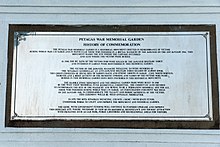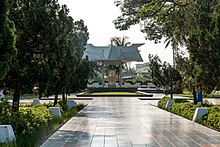Jesselton revolt
| Jesselton revolt | |
|---|---|
British North Borneo | |
| Result |
Japanese victory.
|
• Occupied British Borneo
![]() Overseas Chinese Defence Association
Overseas Chinese Defence Association
• Chinese National Salvation Association![]() North Borneo Volunteer Force
North Borneo Volunteer Force![]() North Bornean indigenous volunteers
North Bornean indigenous volunteers![]() Philippine indigenous volunteers
Philippine indigenous volunteers![]() Members of Indian Imperial Police
Members of Indian Imperial Police
Limited arms support:
≈Thousands Japanese troops (post 1943)
The Jesselton revolt (also known as the Jesselton uprising or the Double Tenth Revolt/Incident) was a revolt by a
The movement succeeded in killing around 50–90 Japanese police and soldiers and temporarily took control of
The leader of the revolt finally decided to surrender following Japanese threats to execute more civilians if the guerrillas did not turn themselves in. Following the arrest and subsequent execution of the rebel alliance, the Japanese returned to administer North Borneo until 1945 when the main Allied liberation mission arrived.
| History of Malaysia |
|---|
 |
|
|
Background

Due to persistently harsh rule under the Japanese occupation, resistance against the Japanese developed, especially on the west coast of North Borneo, where a revolt was led by
In February 1942, Kwok wanted to establish contact with the Australians or Americans in eastern North Borneo, but he was unable to continue his trek by foot across the island jungle when he reached
In May 1943, Kwok returned to Jesselton greatly determined to liberate North Borneo. Upon arrival, he first contacted the
Uprising

As the date of execution for a pending Japanese decree to seize any in opposition to the Japanese administration loomed closer, the resistance group was forced to launch their revolt ahead of schedule. With many of his members armed with only
In the combined land and sea attack on the Japanese, most inhabitants of the islands around the coastal areas contributed ships to the movement. Native
From land, the revolt was supported by native
After the successful revolt, the resistance movement under OCDA and NBVF jointly hoisted the flag of the Republic of China and Union Jack on 10 October 1943.[8] Most of the members of the OCDA were loyal to the Republic of China while the NBVF remained loyal to the United Kingdom, although the NBVF was not even recognised by the British government.[8]
With Imperial Japanese reinforcements from
Aftermath and legacy

Following the arrival of Japanese reinforcements, the Japanese authorities subsequently launched a ruthless counter-offensive by bombing coastal settlements from
After the war, the International Military Tribunal for the Far East (IMTFE) set up in 1946 to prosecute the many Japanese war crimes concluded that during the resistance movement led by the Chinese and indigenous peoples in North Borneo, the Kenpeitai had been involved in a reign of terror, arresting, torturing, and massacring hundreds of Chinese rebels while systematically exterminating the coastal population of Suluk people.[29][30] The sacrifice of the movement was honoured with a memorial in Petagas, the Petagas War Memorial, today just east of the Kota Kinabalu International Airport.
Notes
Footnotes
- ^ Tarling 2001, p. 196.
- ^ Ham 2013, p. 166.
- ^ a b Tregonning 1960, p. 88.
- ^ a b Danny 1998, p. 154.
- ^ Goodwin 1953, p. 31.
- ^ Evans 1990, p. 50.
- ^ Julitta 2005, p. 312.
- ^ a b c d e f Kratoska 2013, p. 124.
- ^ Reece 1998, p. 162.
- ^ Julitta 2005, p. 318.
- ^ a b Evans 1990, p. 52.
- ^ Dick 1983, p. 55.
- ^ Evans 1990, p. 51.
- ^ Julitta 2005, p. 328.
- ^ Kratoska 2013, p. 125.
- ^ a b Tregonning 1960, p. 89.
- ^ a b Danny 2004, p. 116.
- ^ Kratoska 2013, p. 128.
- ^ Abbas & Bali 1985, p. 159.
- ^ Kratoska 2013, p. 111.
- ^ Luping, Chin & Dingley 1978, p. 40.
- ^ a b Ooi 1999, p. 56.
- ^ a b c Ooi 2010, p. 164.
- ^ Dick 1983, p. 47.
- ^ Hwang 2010.
- ^ Ooi 2010, p. 186.
- ^ Ooi 2013, p. 77.
- ^ Kratoska 2013, p. 113.
- ^ Watt 1985, p. 210.
- ^ Thurman & Sherman 2001, p. 123.
References
- Goodwin, J. W. (1953). Eastern World. Far Eastern.
- Tregonning, K. G. (1960). North Borneo. H.M. Stationery Office.
- Luping, Margaret; Chin, Wen; Dingley, E. Richard (1978). Kinabalu, Summit of Borneo. Sabah Society.
- Dick, Crofton Horton (1983). Ring of Fire: Australian guerrilla operations against the Japanese in World War II. Secker & Warburg. ISBN 978-0-436-20157-8.
- Watt, Donald Cameron (1985). The Tokyo War Crimes Trial: Index and Guide. International Military Tribunal for the Far East. Garland. ISBN 978-0-8240-4774-0.
- Abbas, Ismail; Bali, K. (1985). Peristiwa-peristiwa berdarah di Sabah (in Malay). Institute of Language and Literature, Ministry of Education (Malaysia).
- Evans, Stephen R. (1990). Sabah (North Borneo): Under the Rising Sun Government. Tropical Press.
- Reece, Bob (1998). Masa Jepun: Sarawak Under the Japanese, 1941-1945. Sarawak Literary Society. ISBN 978-983-9115-06-2.
- Danny, Wong Tze-Ken (1998). The Transformation of an Immigrant Society: A Study of the Chinese of Sabah. Asean Academic. ISBN 978-1-901919-16-5.
- Ooi, Keat Gin (1999). Rising Sun over Borneo: The Japanese Occupation of Sarawak, 1941–1945. Palgrave Macmillan. ISBN 978-1-349-27300-3.
- Thurman, Malcolm Joseph; Sherman, Christine (2001). War Crimes: Japan's World War II Atrocities. Turner Publishing Company. ISBN 978-1-56311-728-2.
- Tarling, Nicholas (2001). A Sudden Rampage: The Japanese Occupation of Southeast Asia, 1941-1945. C. Hurst & Co. Publishers. ISBN 978-1-85065-584-8.
- Danny, Wong Tze-Ken (2004). Historical Sabah: The Chinese. Natural History Publications (Borneo). ISBN 978-983-812-104-0.
- Julitta, Shau Hua Lim (2005). Pussy's in the Well: Japanese Occupation of Sarawak, 1941-1945. Research and Resource Centre, SUPP Headquarters. ISBN 978-983-41998-2-1.
- Hwang, Andrew (2010). "Remember the North Borneo resistance fighters". The Star. Archived from the original on 24 October 2017.
- Ooi, Keat Gin (2010). The Japanese Occupation of Borneo, 1941-1945 (PDF). Routledge. ISBN 978-0-203-85054-1. Archived from the original(PDF) on 25 October 2017.
- Ooi, Keat Gin (2013). Post-war Borneo, 1945-50: Nationalism, Empire and State-Building. Routledge. ISBN 978-1-134-05803-7.
- Ham, Paul (2013). Sandakan. Transworld. ISBN 978-1-4481-2626-2.
- Kratoska, Paul H. (2013). Southeast Asian Minorities in the Wartime Japanese Empire. Routledge. ISBN 978-1-136-12514-0.
Further reading
- Maxwell, J. Hall (1965). Kinabalu Guerrillas: An Account of the Double Tenth 1934 [i.e. 1943]. Borneo Literature Bureau.
- Brooks, Ronald J. (1995). Under Five Flags. Pentland Press. ISBN 978-1-85821-322-4.
- Danny, Wong Tze-Ken (2006). "The Kinabalu Guerrillas in Local and National History" (PDF). Sabah Society Journal. Department of History, Faculty of Arts and Social Sciences, University of Malaya. pp. 19–30. Archived from the original (PDF) on 24 October 2017.
- Danny, Wong Tze-Ken (2007). "The Petagas War Memorial and the Creation of a Heroic Past in Sabah". Journal of the Malaysian Branch of the Royal Asiatic Society. 80 (2 (293)): 19–32. JSTOR 41493694.
- Daily Express (2013). "Granddaughter seeks apology for massacre". Daily Express. Archived from the original on 18 October 2017.
- Lajiun, Jenne (2015). "Relatives share stories of Sabah fallen heroes". The Borneo Post.
- Daily Express (2015). "Albert Kwok's daring raid". Daily Express. Archived from the original on 24 October 2017.
- Daily Express (2017). "82-year-old recalls execution of hero dad in Petagas". Daily Express. Archived from the original on 28 October 2017.
- Ralon, Larry (2019). "Man recalls how father, brother perished in war". Daily Express. Archived from the original on 22 January 2019.


